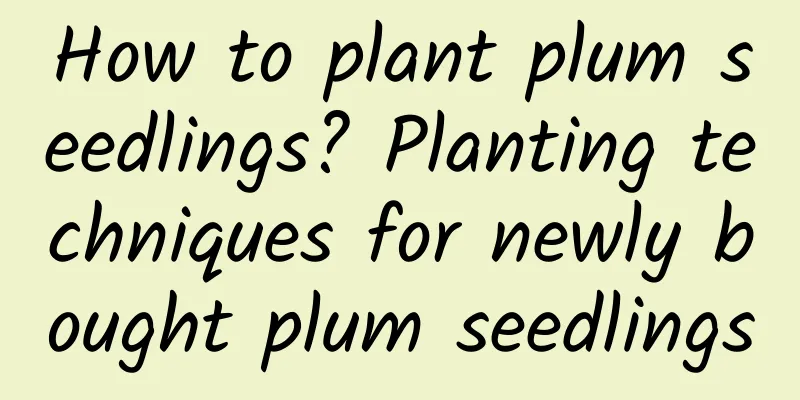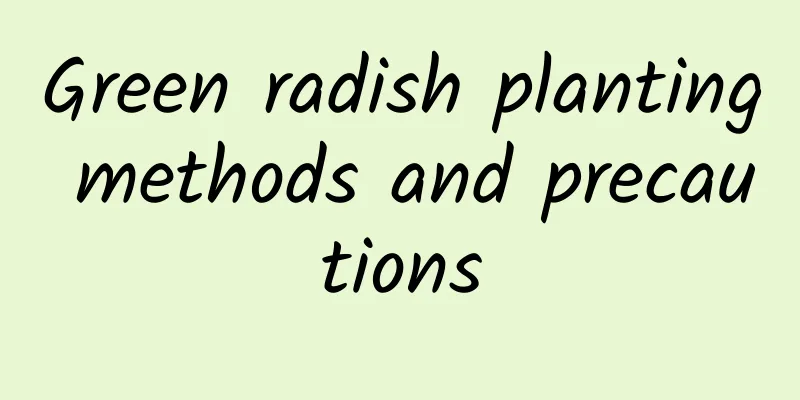How to plant plum seedlings? Planting techniques for newly bought plum seedlings

|
Plum is a very important economic fruit tree. There are many varieties currently planted, and the demand for them varies greatly from market to market. The flesh is crispy and juicy, and the taste varies from sour to sweet, so when planting plums, choosing the right variety is the key. So how do you plant plum seedlings? How to plant plum seedlings1. Garden selection Choose to plant plum seedlings in plots with high soil fertility, deep soil layer and easy drainage. Although plum seedlings have strong adaptability to soil, in order to produce high-quality plums, the soil environment must be strictly controlled. After selecting the site, deep plowing and tillage, and application of decomposed organic fertilizer are required. 2. Seedling selection and planting Select pure and strong plum seedlings, avoid diseases and insect pests, and then control the spacing to 3 meters to complete the planting. Because plum trees are self-pollinating, pollination trees need to be intercropped reasonably. 3. Water and fertilizer management After the plum trees are planted, they should be watered once in time to ensure that the trees can absorb nutrients from the soil. During the flowering and fruiting periods, the amount of watering should be increased to promote fruit production. After harvesting in winter, they should be watered once to ensure that the fruit trees can safely overwinter. Plum trees should be fertilized at least 3-4 times. Nitrogen fertilizer should be applied during the growing season to promote the growth of fruit trees. Phosphorus and potassium fertilizers should be applied during the flowering period to improve the quality of flowering. Potassium dihydrogen phosphate solution should be sprayed on the leaves during the fruiting period to increase the nutrients of the fruit. 4. Thinning flowers and fruits The fruit setting rate of plum trees is relatively high, so it is necessary to thin out the flowers and fruits appropriately to adjust their nutrient distribution. Flower thinning is generally done during the peak flowering period. Weak flowers will definitely produce very small fruits, which is not conducive to improving commodity attributes. Try to keep large fruits and strong flowers, and thin the fruits in order. 5. Pest and disease control Plum trees are prone to pests such as borer disease, fruit borers, and red spider mites. Once they occur, use carbendazim and thiophanate-methyl to spray to control the borer disease. 2.5% dichlorvos and 20% pyrethroids can be used for spraying to control them. Red spider mites can be sprayed with imidacloprid. Plum tree seedling planting timePlum is a deciduous fruit tree species, suitable for planting between November and early March of the following year. When it matures too early, the plum seedlings have not entered the dormant period, and the seedling stems are not completely lignified; too late, the plum seedlings germinate, and the rising temperature seriously affects the survival rate of planting. |
>>: How to plant newly bought orchids? Planting methods for newly bought orchids
Recommend
What to do if the roots of copper coin grass rot
1. How to deal with it 1. If the root rot is not ...
What's wrong with the black stems of potted roses?
1. Infection with black spot Reason: Around April...
What fertilizer should be applied to make spider plants grow well? Pictures of spider plants
1. What fertilizer should be applied to make spid...
How many compound fertilizers should be put in a pot of green radish?
1. Put a few pills Don't fertilize the green ...
Palm bamboo | Aquatic plants suitable for living rooms
Morphological characteristics Bamboo palm is an e...
How to water succulent jade pendants
Watering tips for succulent jade pendants Succule...
How to keep seeds of Polygonatum sibiricum and how to collect and store them
How to get Polygonatum sibiricum seeds Polygonatu...
What is leek?
What is leek? Leek is a plant of the genus Allium...
Is it good to grow clam orchids at home?
1. Can be raised at home The clam orchid can be g...
How to grow jasmine in summer
1. Fertilization Summer is the main flowering per...
How to grow Anthurium
soil The soil for planting Anthurium can be mixed...
What fertilizer is good for winter melon
Fertilizing Winter Melon Winter melon needs suffi...
The efficacy and function of bearberry
1. Whitening and beauty care The leaves of bearbe...
Time and method of changing soil in Jade Dew
Time to change the soil Jade plant is usually rep...
When and how to plant water lilies
Water lily planting time Water lilies are suitabl...









